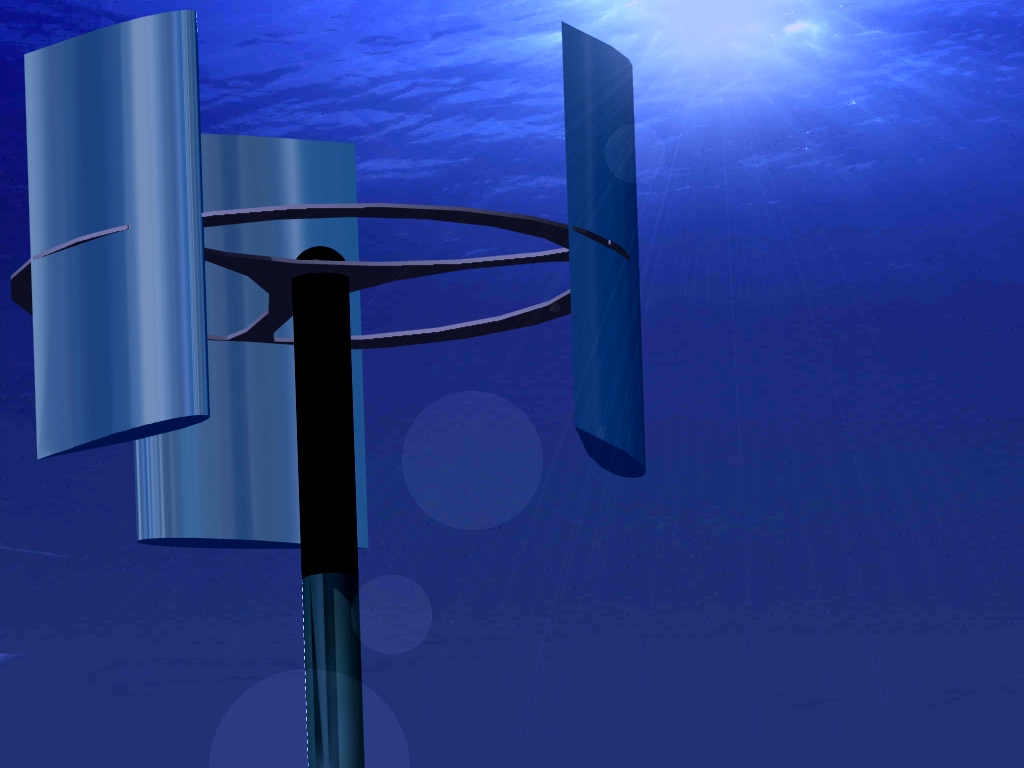| Turbine
Theory |
Intro
These are a far more intriguing device compared to a horizontal axis type, whose principle of operation may not be immediatly apparent, but under consideration is a fair bit neater than that of a horizontal axis type. Once again, they work similarly to their wind powered counterparts and again it is the properties of water and hydrodynamics that will dictate their size and shape.
Principle of operation: near vertical blades rotate eccentrically about an axis. If the blades are moving with some rotational velocity, then the resultant velocity as seen by the blades at certain azimuthal positions as they complete their orbit will generate hydrodynamic forces which may be resolved normal and tangentially to the blade path, and be seen to provide a tangential forcing in the direction of blade movement. As long as the cumulative thrust of the blades is above a certain threshold, the blades will autorotate. The threshold is either that where the blades merely have to overcome their own drag in the free turbine case, or when there is a reacting torque which they must also overcome, in a generating turbine situation. Either way, it is unlikely that the turbine will be able to generate enough torque to start rotation on its own, as it is only under rotation that the blades generate sufficient tangential thrust to counter blade drag, so in practice some sort of self starting motor will be required. This is not a problem, as generators are often exceptionally adept working as motors. The other main operational difference between these and horizontal type turbines is that the vertical type will happily operate independently of the direction of the inflow, since it is essentially axis-symmetric.
Modelling: elements of BEMs may be applied to the vertical turbine.
It can he modelled as an actuator disk (or more realistically
as two). Instead of annular control volumes encompassing annular
streamtubes (as in BEMs), the streamtubes for this blade element
analysis are considered as encompassing the blade at each point
of its circumferential trajectory. The fact that blade angle of
attack is dependant on the angle of the resultant of inflow and
tangential velocities means that blade forces must be calculated
at as many azimuthal points as possible and the torque is then
time averaged over the cycle.
The double-multiple streamtube extension (by
Paraschivoiu) of Strickland’s
multi-streamtube model of a Darrieus turbine is used to calculate
shaft power and torque for a number of generic turbines in a range
of flow conditions. The model is again computationally quick,
and provides an accurate description of physical processes and
turbine characteristics.
back to top

Model
The vertical axis marine current turbine is not in large scale production, and even large scale vertical axis wind turbines are few and far between. As such, the design for our model is based on postulation as to design criteria and engineering judgement.
The turbine is likely to experience forces of similar magnitude as the horizontal axis type, and it is proposed that as such blades should be fairly thick to allow the structural rigidity necessary, and it is assumed that the troposkein shape familiar of wind turbines is not necessary, as the rotational velocities experienced are unlikely to generate the same centrifugal forces. Therefore, all our VAMCTs are of the H-Darrieus type and equipped with NACA 0018 section blades.
Results from the model may be downloaded in PDF format from the results download package here.
| Turbine
Theory |
Go back to Contents

 Home
Home 
